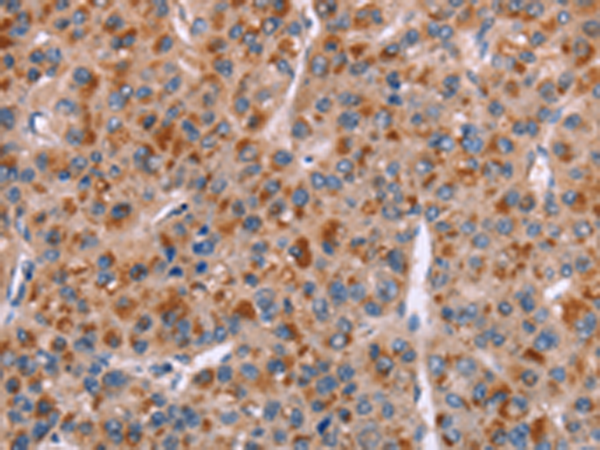

| WB | 咨询技术 | Human,Mouse,Rat |
| IF | 咨询技术 | Human,Mouse,Rat |
| IHC | 1/25-1/100 | Human,Mouse,Rat |
| ICC | 技术咨询 | Human,Mouse,Rat |
| FCM | 咨询技术 | Human,Mouse,Rat |
| Elisa | 1/1000-1/2000 | Human,Mouse,Rat |
| Aliases | Geph |
| Host/Isotype | Rabbit IgG |
| Antibody Type | Primary antibody |
| Storage | Store at 4°C short term. Aliquot and store at -20°C long term. Avoid freeze/thaw cycles. |
| Species Reactivity | Human, Mouse, Rat |
| Immunogen | Synthetic peptide of human GPHN |
| Formulation | Purified antibody in PBS with 0.05% sodium azide and 50% glycerol. |
+ +
以下是关于GPHN抗体的3篇参考文献及其摘要概括:
1. **"Gephyrin antibodies in GAD-positive and GAD-negative stiff-person syndrome"**
- **作者**: Butler et al. (2010)
- **摘要**: 该研究发现部分僵人综合征(SPS)患者体内存在针对GPHN的自身抗体,尤其是GAD抗体阴性病例中,提示GPHN抗体可能与SPS的特定亚型相关,并可能通过干扰抑制性突触功能导致运动障碍。
2. **"Autoantibodies to gephyrin in patients with autoimmune encephalitis: clinical correlates and diagnostic implications"**
- **作者**: Landa et al. (2018)
- **摘要**: 研究报道了GPHN抗体在自身免疫性脑炎患者中的存在,这些患者表现出精神症状、癫痫和运动障碍,提示GPHN抗体可能通过破坏突触后抑制性受体聚集参与致病机制。
3. **"Structural basis of gephyrin clustering at inhibitory synapses"**
- **作者**: Kowalczyk et al. (2013)
- **摘要**: 该研究解析了GPHN蛋白的三维结构及其在抑制性突触中的自组装机制,为理解GPHN抗体如何干扰突触功能提供了分子基础,并可能指导相关自身免疫疾病的治疗策略。
4. **"Glycine receptor autoantibodies and gephyrin antibodies in progressive encephalomyelitis with rigidity and myoclonus"****
- **作者**: Carvajal-González et al. (2014)
- **摘要**: 研究揭示了GPHN抗体与甘氨酸受体抗体在进展性脑脊髓炎伴强直及肌阵挛(PERM)中的共存现象,表明GPHN抗体可能协同其他自身抗体加剧中枢神经系统的过度兴奋性。
Gephyrin (GPHN) is a pivotal scaffolding protein that plays a central role in the organization and stabilization of inhibitory postsynaptic neurotransmitter receptors, particularly glycine and γ-aminobutyric acid type A (GABAA) receptors, in the central nervous system. It acts as a critical molecular hub at postsynaptic sites, anchoring receptors to the cytoskeleton via its interactions with microtubules and dynein light chain. Structurally, GPHN consists of an N-terminal G-domain (involved in receptor clustering) and a C-terminal E-domain (mediating oligomerization and microtubule binding).
GPHN antibodies are essential tools in neuroscience research, enabling the visualization and study of inhibitory synapse architecture and plasticity. They are widely used in techniques like immunohistochemistry, Western blotting, and immunofluorescence to map GPHN distribution in neuronal tissues, assess synaptic density, or investigate alterations in neurological disorders. Dysregulation of GPHN expression or function has been implicated in epilepsy, autism spectrum disorders, schizophrenia, and neurodegenerative diseases. For instance, reduced GPHN levels correlate with impaired inhibitory neurotransmission in epilepsy models. Additionally, autoantibodies targeting GPHN have been identified in rare autoimmune encephalopathies, highlighting its clinical relevance.
These antibodies also aid in exploring GPHN’s non-synaptic roles, such as its involvement in molybdenum cofactor biosynthesis. Research using GPHN knockout models underscores its indispensability for synaptic inhibition and survival, as its absence leads to severe neurological deficits. Overall, GPHN antibodies remain vital for advancing our understanding of synaptic pathology and therapeutic development.
×